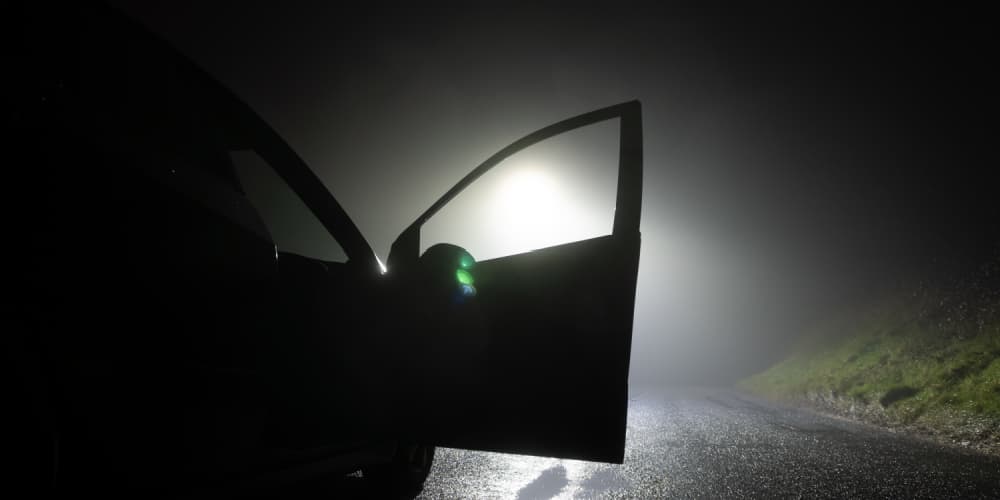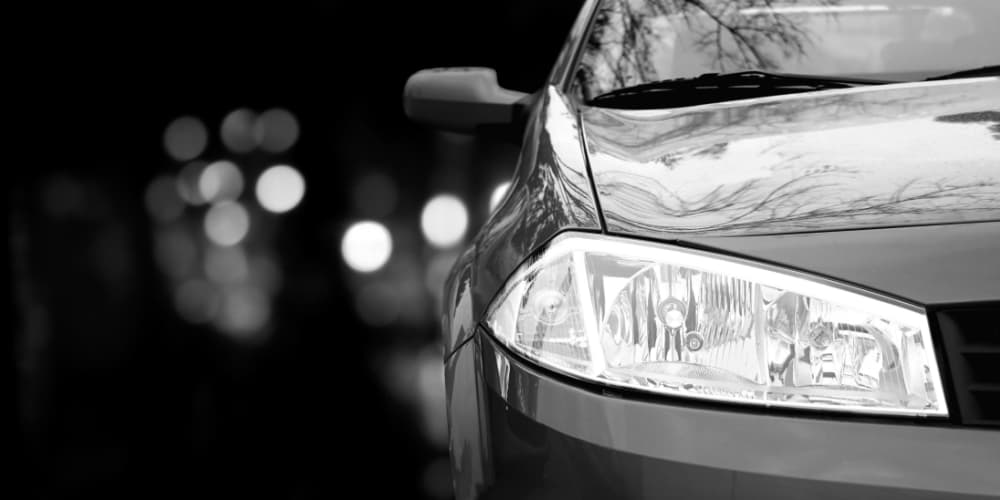
The spooky stories of the 4 most haunted cars in history
31st Oct, 2024
One interesting quirk of human psychology is that we tend to anthropomorphise inanimate objects, including cars – a scientific way of saying that we assign human characteristics to them. It’s an evolutionary byproduct of a once-essential survival trait; for millennia, the ability to distinguish between human and non-human entities was the main thing that stopped our ancestors ending up in the bellies of wild animals.
Fast forward to today, and we all tend to spend a considerable amount of time with our cars. We see faces in them, we give them names, and we assign personalities to them. The scary thing is that some of those personalities can seem a lot more sinister than others.
Of course, maybe it’s nothing more than that old human tendency to see patterns where none exist. Or maybe there really are ghosts in the machine. How else do you explain…
James Dean’s Porsche 500 Spyder

“Please do not get into that car.” So went the words of British actor Alec McGuinness to Hollywood heartthrob James Dean. It was 1955 in Los Angeles, and the young actor had just revealed his pride and joy – a brand new car. It was a conversation McGuinness could still remember very clearly when he relayed it during an interview decades later.
“Please do not get into that car, because if you do’ — and I looked at my watch — and I said, ‘if you get into that car at all, it’s now Thursday (Friday, actually), 10 o’clock at night and by 10 o’clock at night next Thursday, you’ll be dead if you get into that car.’”
The words proved eerily prophetic. Seven days later, the young actor was killed in an almost head-on collision on California State Route 46, on the way to a racing event. (An event we’ve written about before here at Scrap Car Network.)
Dean’s death prompted an outpouring of global grief – but it was far from the only death associated with the Spyder. In the wake of the young star’s passing, automotive legend George Barris took it apart and sold the engine and drivetrain to two racers, William Eschrich and Dr Troy McHenry. Eschrich was promptly injured and McHenry was killed in the same race shortly afterwards.

Over the next few years, calamity followed the Spyder wherever it went. A fire broke out at the museum where it was displayed (as part of an exhibit illustrating the consequences of dangerous driving). The Porsche survived with minimal damage. Around the same time, rumours swirled that Barris sold a couple of tyres from it, which blew out at the same time, causing their new owner to swerve off the road. Luckily he was unharmed.
Later, it fell off its stand at another exhibit, breaking the hip of a bystander. It fell off its trailer multiple times while being transported, killing a man named George Barkus – the driver responsible for taking it to its various shows and exhibitions.
It’s a strange tale with an equally strange ending. True to form, it finally went missing in 1960. The popular tale goes that it was from a sealed train boxcar, and others say that it vanished from the back of a truck that was transporting it. The boxcar story is a classic locked-room mystery, but even if the truck story is the one that really happened, most versions of the tale say that the Spyder was missing its engine. A £775,000 reward was offered for its safe return in 2005, but still to this day it’s never been found.
The Black Volga of Eastern Europe

In the 1960s and 70s, mysterious tales emerged from Eastern Europe of a ghostly black car roaming the city streets – often in the Soviet Union, but sometimes in neighbouring countries too. Sightings were reported in Poland, Romania, Hungary, Russia, Belarus, Ukraine, Greece, and Mongolia.
The car in question was sometimes said to be a BMW or Mercedes, but in most tales it was generally identified as a Volga, a Russian model widely used across the Soviet Union. Speculation varied about the identity of its mysterious driver, encompassing everyone from common criminals and ostracised ethnic groups (who were sometimes thought of as one and the same) all the way up to secret police or diabolical cultists. Sometimes the driver was said to be none other than the devil himself.
The details of its nefarious doings varied almost as much as the supposed identity of its driver, and it was often said to be responsible with abductions and deaths of innocent passers-by. In some stories, victims were kidnapped by criminals or agents of the state to be murdered so that their blood could be used as a cure for rich Westerners.
These tales were given credence by several very real factors. For starters, to save money on paint, the Volga was only ever available in black, which arguably gave every one of the real cars a slightly sinister air. What’s more, the Volga was strongly associated with the NKVD (the Soviet secret police) as they were known to use it as a service vehicle. (It’s possible that these stories were even encouraged by some governments as deliberate propaganda.)

In other retellings, the abductions are decidedly more supernatural in nature, with bystanders said to be “sucked inside” like a vacuum cleaner. One story goes that a witness saw a pair of girls being taken by the Volga. Our brave / foolish bystander managed to make it to the car, opening the door to reveal – nothing. The front of the car was empty. There was a blinding flash, and that’s all our would-be hero remembered when he woke up 24 hours later with a pounding headache.
In other cases, people who approached the car were supposedly killed instantly, or told they would die at a precise time within the next 24 hours (and then did). The driver would ask passers-by the time, and then kill or condemn them when they approached the car to answer. However, there was a way out if you knew the stories – when asked the time, if you answered: “it is God’s time”, the Volga would quickly vanish.
There were some telltale signs, if you knew what to look for. 666 on the number plate. A black car with noticeable white elements, like wheels and curtains. Tyre rims appearing out of nowhere, or ram’s horns where the side mirrors would be (which would almost definitely not be road-legal).
These stories appeared to peter out towards the end of the 1990s, with the collapse of the Soviet Union – but the legends of the Black Volga still remain.
Number 7 London Bus

Okay, so in terms of spooky monikers, “The Black Volga” has a lot more going for it than “The Number 7 Bus”. After all, if you’ve ever been to London, even if only briefly, those distinctive red buses are dime-a-dozen. Arguably, even quite a comforting sight for many Londoners, who often regard them as a symbol of home.
However, buses are rather less comforting when they’re screaming towards you down the middle of the road in the dead of night, which is largely what the Number 7 is known for. In case something about the scene sounds familiar, this wasn’t quite as whimsical as it was in that Harry Potter film. When one unlucky driver encountered the Phantom Bus, he swerved wildly and crashed into a wall, whereupon the car burst into flames. Several witnesses later testified to what they saw as being the main cause of the fatal crash – a red bus, unmanned and unmarked aside from a large number 7 on its side, driving madly down the road and then suddenly disappearing.
That was back in the 1930s. For the next 60 years, until the late 1990s, the Phantom Bus was witnessed by hundreds of other drivers and pedestrians, many of whom reported their own near-misses with it. Some details of their stories varied, but most agreed that the Number 7 appeared around Cambridge Gardens at 1:15am, at a time when no buses were scheduled to run.
Since the area was reconstructed in the 1990s, the Phantom Bus seems to have faded into the proverbial darkness. If you’re ever driving around there in the early hours though, it might be worth keeping a particularly keen eye on the roads around you. Objects in the mirror might be closer than they appear…
The Jumping Car of Cape Town

Let’s set the scene. It’s night in Cape Town in South Africa, and a family is asleep after a dinner party for some friends. Suddenly, they’re woken by a terrible racket; the roaring of a car engine. Understandably worried that their Renault Megane was being stolen, they leapt from their beds and sprinted outside – only to find no intruders. The car had come to life of its own volition, its driver and passenger seats still completely empty.
The family inspected it (can’t imagine anyone readily volunteered for that) and found no keys in the ignition, so they called the police. When the local law enforcement arrived, they were understandably sceptical. However, the Megane clearly had an instinct for the theatrical, because it roared to life again right then and there. The car continued ‘jumping’ until it ran into a tree, at which point it finally petered out.
No less than nine people saw what happened. It was of course reported to Renault, but the official company stance is “unconvinced”. Officials suggested it may well be the result of a faulty starter motor – perhaps a rusty cable caused a short circuit, which could explain what happened. But then again, that doesn’t explain the roaring sound. Fingers crossed it’s a mischievous rather than a malevolent presence. Perhaps just the spirit of the open road!
In fact, as the Jumping Car of Cape Town neatly demonstrates, some rather spooky happenings in your car can sometimes have quite a mundane explanation – it’s just reaching the end of its natural life. And if your car is giving up the ghost, who better to give you the very best price than us right here at Scrap Car Network? All you need to do is enter your car reg and postcode into the fields on our site, and we’ll get you an instant online quote before you can say cash for cars. It only takes a few seconds. So then – curious to find out how much your car is worth?